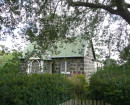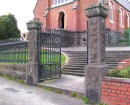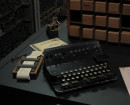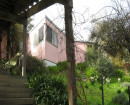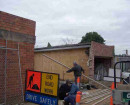Swan Island Submarine Mining Station
Swan Island, QUEENSCLIFFE BOROUGH
-
Add to tour
You must log in to do that.
-
Share
-
Shortlist place
You must log in to do that.
- Download report
Statement of Significance
Swan Island is significant as an outstanding and intact example of the fortifications designed as part of the Victorian Colonial Coastal Defence System, which contributed to making Port Phillip Bay reputedly the most heavily defended harbour in the Southern Hemisphere in the late nineteenth and early twentieth centuries (Criteria A.4 and D.2). The fort is significant as an example of late nineteenth century British military fortification design, including a distinctive V-shaped battery sited low and close to the sea, a rear garrison or keep, and extensive use of concrete, parapets and bursting layers of sand and concrete (Criterion D.2). The island is a rare example in Australia of a fort designed to contain the facilities for laying, preparing, storing and transporting submarine mines. (Criterion B.2) The fortifications and military structures on the island are significant for their association with the development of coastal defence methods and the rapid advances in artillery, mining and shipping technology during the late nineteenth and early twentieth centuries (Criterion F.1). The fort and former submarine mining complex is significant for its ability to demonstrate the continuity of occupation of the island for military activities, from the 1870s to the present day. In particular, the variety of design and construction methods of the structures are important in illustrating the sequence and changing uses of the fort over time, from an army battery and naval mining depot to a military training facility (Criterion D.2). The former garrison or keep is significant as an important and rare example of Colonial military architecture associated with coastal defence in Victoria (Criterion B.2). The residences on the island are significant as representative examples of late nineteenth century military housing, illustrating architectural design standards and living conditions in that period. (Criterion D.2) The design of the Swan Island Fort is significant for its association with Colonel Peter Scratchley, influential in the development of the Australian Defence Forces, and Colonel Drummond Jervois of the Royal Engineers and Deputy Inspector of General Fortifications in Great Britain. Scratchley and Jervois were responsible for the design of the Port Phillip fortifications system as part of Australia's coastal defence strategy (Criterion H.1). The island is significant for its association between 1879 and 1921 with the Victoria Military Forces, the Royal Australian Engineers and the Royal Australian Artillery, encompassing an important period in the formation of the Australian Defence Forces (Criterion A.4).
The jetty structures are significant as examples of the fort's submarine mining activities in the harbour prior to the introduction of propelled torpedoes after World War One (Criteria A.4 and D.2). The beach preservation works, including groins and seawalls built between c 1940 and 1972, are important for their association with earlier attempts to control sand movement and protect military structures on the island's eastern foreshore from the effects of beach erosion (Criteria A.4 and D.2). The island contains significant specimens of mature cypress trees associated with the earliest period of occupation of the fort (Criterion D.2). The wrecks of the 'Countess of Hopetown' and J-3 Submarine are significant for their association with the Royal Australian Navy's (RAN) coastal defence system, the 'Countess of Hopetown' serving as the principal harbour defence vessel during World War One. The J-3 Submarine is also significant for its use as a source of power to supply the military facilities on Swan Island. The island also contains places of potential Aboriginal cultural significance and maritime archaeological relics still to be identified and assessed.
Heritage Inventory
-
-
Swan Island Submarine Mining Station - Physical Description 1
About 140ha, 3km north-east of Queenscliff, comprising the area of Swan Island east of AMG easting 55HBT96800m east and above the mean low water mark (lwm).
Swan Island contains an extensive range of structures, earthworks and tunnels comprising the former fort and mines depot.
Swan Island has buildings from the 1880s submarine mining station.Swan Island Submarine Mining Station - Historical Australian Themes
Providing administrative structures and authorities - defence
Swan Island Submarine Mining Station - Usage/Former Usage
Defence
Veterans Description for Public
Swan Island Submarine Mining Station - Veterans Description for Public
The Swan Island Fort was used to protect the minefields in the harbour, and to engage enemy shipping that managed to pass the primary defences of Forts Queenscliff and Nepean. As a result, Swan Island Fort was also designed as a submarine mining depot.The jetty structures are significant as examples of the fort's submarine mining activities in the harbour prior to the introduction of propelled torpedoes after the First World War. Also present at the siteare the wrecks of the 'Countess of Hopetown' and J-3 Submarine, once an essential part of the Royal Australian Navy's (RAN) coastal defence system. The 'Countess of Hopetown' served as the principal harbour defence vessel during the First World War. The J-3 Submarine was significant as a source of power to supply the military facilities on Swan Island.
-
-
-
-
-
SWAN ISLAND
 Victorian Heritage Inventory
Victorian Heritage Inventory -
Swan Island Fort
 Vic. War Heritage Inventory
Vic. War Heritage Inventory -
Swan Island Submarine Mining Station
 Vic. War Heritage Inventory
Vic. War Heritage Inventory
-
'ELAINE'
 Boroondara City
Boroondara City -
-oonah
 Yarra City
Yarra City -
..eld House
 Yarra City
Yarra City
-
-



